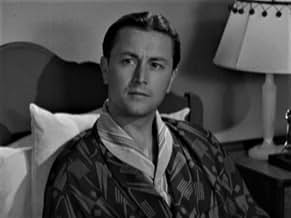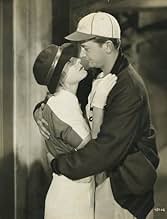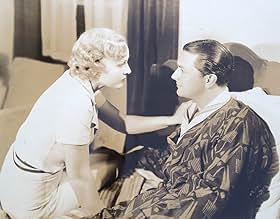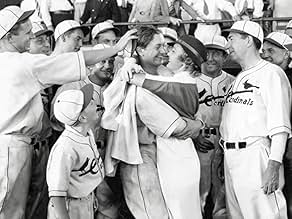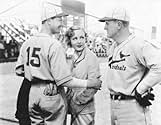अपनी भाषा में प्लॉट जोड़ेंA losing baseball team starts losing its players to strange killings, and the team's new pitcher takes a swing at finding the killer.A losing baseball team starts losing its players to strange killings, and the team's new pitcher takes a swing at finding the killer.A losing baseball team starts losing its players to strange killings, and the team's new pitcher takes a swing at finding the killer.
Joe Sawyer
- 'Dunk' Spencer
- (as Joe Sauers)
Ernie Alexander
- Dick
- (बिना क्रेडिट के)
Brooks Benedict
- Game Radio Announcer
- (बिना क्रेडिट के)
Bruce Bennett
- Man on Ticket Line
- (बिना क्रेडिट के)
Red Berger
- Baseball player
- (बिना क्रेडिट के)
फ़ीचर्ड समीक्षाएं
Death on the Diamond (1934)
The title and plot sound serious but this is a corny, lighthearted spin on murder and racketeering in America's pastime. And leading man Robert Young plays it so breezy you can't quite take his pitching, or his romancing, seriously.
Which is all intentional, no doubt. This is purely entertainment, and in the style of a B-movie at the time, along the lines of many of the murder mystery series that were so popular. The acting and the plots are functional, and fun enough to work, and there is one main hook to keep you interested. Or at least me interested in this one. I knew after ten minutes the movie had no real merit, but I watched it anyway, just to see how they handled the idea.
The idea is sensational: a famously bad baseball team (the St. Louis Cardinals) is surprisingly good thanks to their new sensational pitcher. So a notorious gambler is going to lose big money, and an aggressive businessman is going to fail to buy the team at the end of the season. But only if, in fact, the Cardinals continue to win. So key players start to die. Yes, they are murdered in all kinds of ways. It's a terrifying idea, and I suppose feasible even if preposterous, and you do wonder what the league, and the players, and the fans, and the cops would do.
Well, it is all handled rather lightly. The show must go on, and baseball must be played. Even as bodies are found in the middle of a game, there is no sense that murder trumps nine innings of play, and you really do have to roll your eyes. And then the characters go along with it, too, showing no real fear that they might be next. The actual killers are never really seen—just a shadow, or the barrel of a gun—and so the suspense is deliberately kept low key.
Baseball fans, and baseball movie fans, will no doubt find something to like here. There is a bit of actual footage at the St. Louis baseball stadium, and quite a few actual ballplayers are used in background roles. Young isn't a completely awful pitcher, but you can see when he's pitching in front of a projected backdrop at the studio. There is one little baseball gaffe, it seems—in the bottom of the 9th, St. Louis needs one run to win, but they post two runs, allowing an extra baserunner to score (it wasn't a home run), which isn't how the rules work today, at least.
See this? Not unless you really love baseball.
The title and plot sound serious but this is a corny, lighthearted spin on murder and racketeering in America's pastime. And leading man Robert Young plays it so breezy you can't quite take his pitching, or his romancing, seriously.
Which is all intentional, no doubt. This is purely entertainment, and in the style of a B-movie at the time, along the lines of many of the murder mystery series that were so popular. The acting and the plots are functional, and fun enough to work, and there is one main hook to keep you interested. Or at least me interested in this one. I knew after ten minutes the movie had no real merit, but I watched it anyway, just to see how they handled the idea.
The idea is sensational: a famously bad baseball team (the St. Louis Cardinals) is surprisingly good thanks to their new sensational pitcher. So a notorious gambler is going to lose big money, and an aggressive businessman is going to fail to buy the team at the end of the season. But only if, in fact, the Cardinals continue to win. So key players start to die. Yes, they are murdered in all kinds of ways. It's a terrifying idea, and I suppose feasible even if preposterous, and you do wonder what the league, and the players, and the fans, and the cops would do.
Well, it is all handled rather lightly. The show must go on, and baseball must be played. Even as bodies are found in the middle of a game, there is no sense that murder trumps nine innings of play, and you really do have to roll your eyes. And then the characters go along with it, too, showing no real fear that they might be next. The actual killers are never really seen—just a shadow, or the barrel of a gun—and so the suspense is deliberately kept low key.
Baseball fans, and baseball movie fans, will no doubt find something to like here. There is a bit of actual footage at the St. Louis baseball stadium, and quite a few actual ballplayers are used in background roles. Young isn't a completely awful pitcher, but you can see when he's pitching in front of a projected backdrop at the studio. There is one little baseball gaffe, it seems—in the bottom of the 9th, St. Louis needs one run to win, but they post two runs, allowing an extra baserunner to score (it wasn't a home run), which isn't how the rules work today, at least.
See this? Not unless you really love baseball.
This is an OK film. If you have 70 minutes to kill, this isn't something you'll regret killing them with, but it won't stick with you years later.
The film centers on a series of bizarre murders of top players on a losing St. Louis baseball team. The owner (David Landau as Pop Clark) has mortgaged everything to recruit pitcher Larry (Robert Young). If the season is bad he loses everything to his creditors. There is "the obvious suspect" in one particular gangster and gambler who seems unhappy about the improving stats of the St. Louis team with Larry on the mound, but that's the point. He seems just a little too obvious.
The first criminal thing to happen is that a tire on the car that Larry is riding in being shot out. The car rolls over and Larry could have been killed, but he's not, and that doesn't seem to have been the intention. There are clearly at least two people involved in this first shooting, but they are anonymous. All of the crimes that follow are actually murders or attempted murders and very un-gangland like - poison being substituted for mustard, a player being strangled with the murderer's bare hands, etc. So, Larry, now recovered, is the team's only hope of winning the pennant. Will he play or will he stay safe? Watch and find out.
This film is noteworthy for several reasons. For one, it really is a mystery as to who is doing all of this, as the gangland gambler is the only obvious suspect, and keeps the film interesting. It also gives David Landau, who played so many villains, a chance to play a good but crusty fellow for a change. Paul Kelly as a newspaperman who is investigating the murders as much as he is covering the team by the time the film is over is always a welcome sight with his likable wise-guy persona. The police are certainly messing up this investigation, so it is good to have Kelly on the case.
And now the not so good stuff. The romance between Pop's daughter (Madge Evans) and Larry falls flat as a pancake. There is zero chemistry there - Gable and Harlow these two are not. They were both good supporting players, but until Robert Young took on his TV roles when he was older, I just never thought much of him as a leading man, particularly over at MGM. Then there is Ted Healy. He is just not funny. When he cut the Three Stooges loose it was the best thing that could have happened to them.
I'd still recommend it for the murder mystery.
The film centers on a series of bizarre murders of top players on a losing St. Louis baseball team. The owner (David Landau as Pop Clark) has mortgaged everything to recruit pitcher Larry (Robert Young). If the season is bad he loses everything to his creditors. There is "the obvious suspect" in one particular gangster and gambler who seems unhappy about the improving stats of the St. Louis team with Larry on the mound, but that's the point. He seems just a little too obvious.
The first criminal thing to happen is that a tire on the car that Larry is riding in being shot out. The car rolls over and Larry could have been killed, but he's not, and that doesn't seem to have been the intention. There are clearly at least two people involved in this first shooting, but they are anonymous. All of the crimes that follow are actually murders or attempted murders and very un-gangland like - poison being substituted for mustard, a player being strangled with the murderer's bare hands, etc. So, Larry, now recovered, is the team's only hope of winning the pennant. Will he play or will he stay safe? Watch and find out.
This film is noteworthy for several reasons. For one, it really is a mystery as to who is doing all of this, as the gangland gambler is the only obvious suspect, and keeps the film interesting. It also gives David Landau, who played so many villains, a chance to play a good but crusty fellow for a change. Paul Kelly as a newspaperman who is investigating the murders as much as he is covering the team by the time the film is over is always a welcome sight with his likable wise-guy persona. The police are certainly messing up this investigation, so it is good to have Kelly on the case.
And now the not so good stuff. The romance between Pop's daughter (Madge Evans) and Larry falls flat as a pancake. There is zero chemistry there - Gable and Harlow these two are not. They were both good supporting players, but until Robert Young took on his TV roles when he was older, I just never thought much of him as a leading man, particularly over at MGM. Then there is Ted Healy. He is just not funny. When he cut the Three Stooges loose it was the best thing that could have happened to them.
I'd still recommend it for the murder mystery.
As a mystery, Death on the Diamond contains all of the genre trappings to keep you guessing until the end. Nearly half of the cast is set up as "red herrings" and if the unmasking of the real killer is something of a disappointment, it really doesn't matter. The real reason to watch this curio is its cast. Robert Young, one of Hollywood's most underrated leading men, is fine as the cocky star pitcher; his opening scene with Madge Bellamy, who is equally good, crackles with snappy dialogue. Nat Pendleton, as a beefy slugger, and Ted Healy, as a touchy umpire, make a fine comic duo. [Healy's reaction to his pal's untimely demise is surprisingly touching.] And look fast for Walter Brennan as a hot dog vendor and Ward Bond as a cop. The film is rife with an atmosphere of golden age baseball, which helps elevate an average mystery into something imminently watchable.
David Landau is the owner-manager of the St. Louis Cardinals -- for the moment. The franchise's finances have been underwater for a while. Everything he has is mortgaged, and he's spent his last moment buying pitcher Robert Young. If the team can't take the World Series this year, he's finished. But the team performs and it looks like they may go to the World Series, until key players are murdered.
It's a pretty good effort from MGM, with Madge Evans as Landau's daughter and Young's love interest, Nat Pendleton, Ted Healy, Henry Gordon, and the usual assortment of MGM players to add gloss. The mystery is ok, although Young does not do the real investigating. That's up to Paul Kelly. It's the sort of enjoyable programmer that MGM could turn out when they weren't trying for greatness.
It's a pretty good effort from MGM, with Madge Evans as Landau's daughter and Young's love interest, Nat Pendleton, Ted Healy, Henry Gordon, and the usual assortment of MGM players to add gloss. The mystery is ok, although Young does not do the real investigating. That's up to Paul Kelly. It's the sort of enjoyable programmer that MGM could turn out when they weren't trying for greatness.
The only reason to see this picture is for its historical value. You can trace the beginnings of some Hollywood careers as the film contains some famous movie names. It is also an interesting commentary on how sophisticated Major League baseball has become in the ensuing years; major league rules, regulations and business structure - how innocent and unstructured life and baseball were years ago.
It's a nice vehicle for Robert Young and the lovely Madge Evans but the story is trite and predictable. There are numerous plot holes to navigate but if you can just overlook them you can make your way through a harmless 69 minutes.
It's a nice vehicle for Robert Young and the lovely Madge Evans but the story is trite and predictable. There are numerous plot holes to navigate but if you can just overlook them you can make your way through a harmless 69 minutes.
क्या आपको पता है
- ट्रिवियाFred Graham was working in the MGM sound department and also playing baseball semi-professionally in his off-time. He was hired to tutor star Robert Young in baseball techniques. He also was hired to double Nat Pendleton in his scenes as a catcher, thereby beginning a nearly 40-year career as an actor and stuntman.
- गूफ़When the game resumes, after the bad guy is caught, the camera pans across the scoreboard to show that the game is tied, 2-2. The radio announcer then states, "Cincinnati hasn't scored since Kelly threw that ball into the dugout and let the tying run come in." Cincinnati was the visiting team and the last run it scored, in the top of the second inning, would have made the score 2-1 (Cincinnati leading). It would not have been a tying run.
- साउंडट्रैकTake Me Out to the Ball Game
(1908) (uncredited)
Music by Albert von Tilzer
Lyrics by Jack Norworth
Played during the opening and closing credits
Played as background music often
टॉप पसंद
रेटिंग देने के लिए साइन-इन करें और वैयक्तिकृत सुझावों के लिए वॉचलिस्ट करें
विवरण
- रिलीज़ की तारीख़
- कंट्री ऑफ़ ओरिजिन
- भाषा
- इस रूप में भी जाना जाता है
- King of the Diamond
- फ़िल्माने की जगहें
- सेंट लुइस, मिसौरी, संयुक्त राज्य अमेरिका(baseball diamond and grandstand backgrounds)
- उत्पादन कंपनी
- IMDbPro पर और कंपनी क्रेडिट देखें
- चलने की अवधि1 घंटा 11 मिनट
- रंग
- पक्ष अनुपात
- 1.37 : 1
इस पेज में योगदान दें
किसी बदलाव का सुझाव दें या अनुपलब्ध कॉन्टेंट जोड़ें

